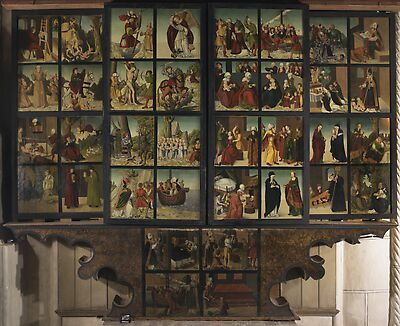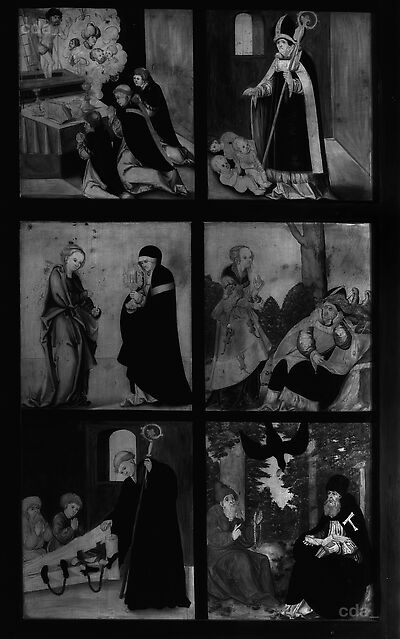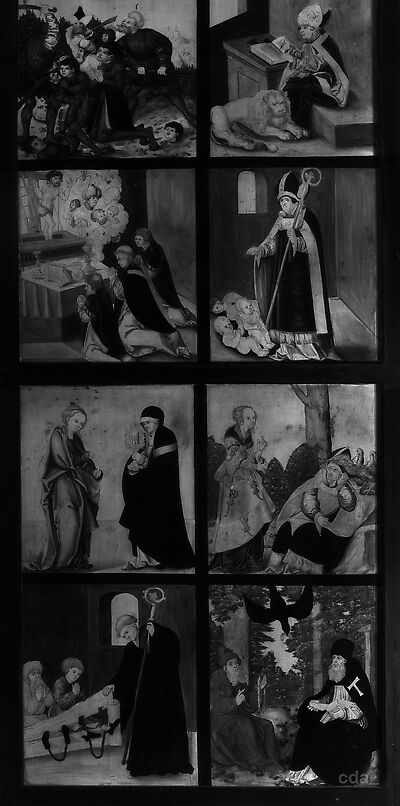The Martyrdom of the Thesbian Legion
DESCRIPTION
Tools/Material:
- fluid, black medium, brush
Type/Ductus:
- freehand and relatively schematic underdrawing
- thin lines
Function:
- relatively binding for the final painted version; the lines define the main contours and describe essential details and facial features; no representation of volume with hatching strokes
Deviations:
- some corrections were made to forms during the painting process; small changes (e. g. bushes in the background)
INTERPRETATION
Attribution:
- not possible (not Cranach workshop)
The Mass of St Gregory
DESCRIPTION
Tools/Material:
- fluid, black medium, brushes of varying widths
Type/Ductus:
- detailed and freehand underdrawing after a pre-existing design
- thin to somewhat broader lines
Function:
- relatively binding for the final painted version; the lines define the main contours and describe essential details and facial features; no representation of volume with hatching strokes
Deviations:
- minor corrections were made to forms during the painting process; small changes (e. g. altarpiece and chalice)
INTERPRETATION
Attribution:
- not possible (not Cranach workshop)
Sts Clare of Assisi and Genoveve
DESCRIPTION
Tools/Material:
- fluid, black medium, brush
Type/Ductus:
- relatively detailed and freehand underdrawing
- thin lines
Function:
- binding for the final painted version; the lines define the main contours and describe essential details and the facial features; no representation of volume with hatching strokes
Deviations:
- almost no corrections were made to forms during the painting process; small changes (e. g. in St Clare’s face and in the robe at the left)
INTERPRETATION
Attribution:
- not possible (not Cranach workshop)
St Leonard liberates the Prisoners
DESCRIPTION
Tools/Material:
- fluid, black medium, brush
Type/Ductus:
- relatively detailed and freehand underdrawing after a pre-existing design
- thin to slightly broader lines
- isolated construction lines
Function:
- relatively binding for the final painted version; the lines define the main contours and describe essential details and facial features; no representation of volume with hatching strokes
Deviations:
- only very minor corrections were made to forms during the painting process; small changes
INTERPRETATION
Attribution:
- not possible (not Cranach workshop)
St Mark the Evangelist
DESCRIPTION
Tools/Material:
- fluid, black medium, brush
Type/Ductus:
- relatively detailed and freehand underdrawing after a pre-existing design
- thin lines
- occasional construction lines
Function:
- binding for the final painted version; the lines define the main contours, describe essential details and facial features, no representation of volume with hatching strokes
Deviations:
- only very minor corrections to forms during the painting process; small changes (e. g. the perspective of the lectern)
INTERPRETATION
Attribution:
- not possible (not Cranach workshop)
A Bishop with Children
DESCRIPTION
Tools/Material:
- fluid, black medium, brushes of varying widths
Type/Duktus:
- detailed and freehand underdrawing after a pre-existing design
- very thin to broader lines
Function:
- relatively binding for the final painted version; the lines define the main contours, describe essential details and facial features; no representation of volume with hatching strokes
Deviations:
- minor corrections were made to forms during the painting process; small changes
INTERPRETATION
Attribution:
- not possible (not Cranach workshop)
St Servatius of Tongeren
DESCRIPTION
Tools/Material:
- fluid, black medium, brushes of varying widths
Type/Ductus:
- relatively detailed and freehand underdrawing after a pre-existing design
- very thin to somewhat broader lines
Function:
- relatively binding for the final painted version; the lines define the main contours, describe essential details and facial features; no representation of volume with hatching strokes
Deviations:
- some corrections were made to forms during the painting process; small changes (e. g. the eagle’s claws, the facial features of the saint)
INTERPRETATION
Attribution:
- not possible (not Cranach workshop)
St Anthony visits Paul of Thebes
DESCRIPTION
Tools/Material:
- fluid, black medium, brushes of varying widths
Type/Ductus:
- relatively detailed and freehand underdrawing after a pre-existing design
- thin to somewhat broader lines
Function:
- binding for the final painted version; the lines define the main contours and describe essential details and facial features; no representation of volume with hatching strokes
Deviations:
- only very minor corrections were made to forms during the painting process; small changes
INTERPRETATION
Attribution:
- not possible (not Cranach workshop)
[Sandner, Heydenreich, Smith-Contini, cda 2017]
![The Bernau Altarpiece [right side wing]: The Golden Legend (Aurea Legenda)](https://lucascranach.org/imageserver-2022/DE_StMB_NONE-001f_FR-none/01_Overall/DE_StMB_NONE-001f_FR-none_2016-02_Overall-s.jpg)

![The Bernau Altarpiece [left alteration wing]: Live of the Virgin [recto], Live of Saints [verso]](https://lucascranach.org/imageserver-2022/DE_StMB_NONE-001c_FR-none/01_Overall/DE_StMB_NONE-001c_FR-none_2016-02_Overall-s.jpg)
![The Bernau Altarpiece [right alteration wing]: The childhood of Christ [recto], Live of Saints [verso]](https://lucascranach.org/imageserver-2022/DE_StMB_NONE-001d_FR-none/01_Overall/DE_StMB_NONE-001d_FR-none_2016-02_Overall-s.jpg)
![The Bernau Altarpiece [left inner wing]: Passion of Christ [verso]](https://lucascranach.org/imageserver-2022/DE_StMB_NONE-001a_FR-none/01_Overall/DE_StMB_NONE-001a_FR-none_2016-02_Overall-s.jpg)
![The Bernau Altarpiece [right inner wing]: Passion of Christ [verso]](https://lucascranach.org/imageserver-2022/DE_StMB_NONE-001b_FR-none/01_Overall/DE_StMB_NONE-001b_FR-none_2016-02_Overall-s.jpg)
![The Bernau Altarpiece [left side wing]: The Golden Legend (Aurea Legenda)](https://lucascranach.org/imageserver-2022/DE_StMB_NONE-001e_FR-none/01_Overall/DE_StMB_NONE-001e_FR-none_2016-02_Overall-s.jpg)
![The Bernau Altarpiece [predella]: St Nicholas legend](https://lucascranach.org/imageserver-2022/DE_StMB_NONE-001g_FR-none/01_Overall/DE_StMB_NONE-001g_FR-none_2016-02_Overall-s.jpg)


